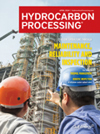October 2016
Columns
Automation Strategies: Identify challenges in alarm management
ARC Advisory Group recently conducted a survey on practices and trends in alarm management in the process industries.

 COPYING AND DISTRIBUTING ARE PROHIBITED WITHOUT PERMISSION OF THE PUBLISHER
COPYING AND DISTRIBUTING ARE PROHIBITED WITHOUT PERMISSION OF THE PUBLISHER
ARC Advisory Group recently conducted a survey on practices and trends in alarm management in the process industries.

Comments